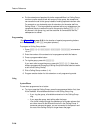
Group Calling—Ring/Page (I7G/I*7G)
5-105
Group Calling—Ring/Page (I7G/I*7G)
Description
This feature lets users ring, page, or transfer calls simultaneously to all of the
extensions in any one of four Calling Groups (G is a Calling Group number from
1–4). When paging, the caller hears a beep and begins speaking; the caller’s
voice is heard on the speakers of all idle system phones in the selected Calling
Group. The first extension to answer the call (by picking up the handset or
pressing
S, or by pressing! to answer a page) is connected to the caller.
Related Features
You must use Calling Group Extensions (#502) to assign extensions to a Calling
Group. Extensions assigned to Calling Group 1 can receive simultaneous paging.
Considerations
■ Extensions can be in more than one Calling Group.
■ Exclude extensions that connect auxiliary equipment (auto attendants,
voice messaging systems, fax machines, internal and external hotline
phones, and doorphones) from Calling Groups.
■ Extensions that have phones without built-in speakers (for example, a
standard phone) will not hear the page.
■ If a Calling Group is in use, a user attempting to page that group hears a
busy tone.
■ If a user leaves the microphone on for hands-free answer on intercom
(HFAI), the microphone is turned off when that phone receives a group
page; the user must lift the handset or press
! to answer the page.
■ Calls can be transferred to a Calling Group manually or using a button
programmed to ring the Calling Group.
■ You can program a Group Calling button on a system phone to ring or page
a specified Calling Group or to transfer a call to a Calling Group with one
touch.
■ When a call is transferred to a Calling Group and the call is not answered, it
goes back to the specified Transfer Return Extension (#306). The call
must be ringing, not a voice page.
Examples
Here are some useful applications for this feature:
■ Group page employees for general announcements; this feature is an
inexpensive alternative to a paging system.


















